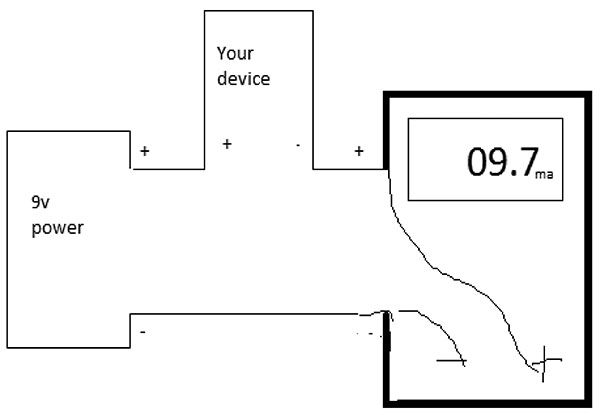The load current you are drawing from your circuit and the time it will take to drain the battery is determined by the capacity of the nine volt battery you're using. How 'long' it will last as you expressed, is the circuit current your device circuit consumes. The average 9 volt battery capacity is given in milliamp hour rating -MAH. For common alkaline batteries it's about 500mah. Very simply 500 milliamps for one hour. This can be expressed differently but equally as half of one ampere for one hour. It's also is 25 mah for twenty hours, or 10mah for 50 hours. We simply divide 500 by your circuit's current load in milliamps, each milli-unit by the way is 1/1000 of an amp, to obtain the device load duration in actual time.

FIGURE 1
Unit measurement is important to understand realtionships in science and technology. You can find this load current draw - with your device, by using a digital multimeter -DMM, and power source like the actual battery, and some connectors. I like to use colored alligator jumpers, black to all marked negatives (see figure 1) and then all red to all positives. You don't have to color code this way but it helps to remember polarity. Set the meter to the high milliamp setting, most often 200 on low cost meters, just as long as it's well above your expected load. The current setting can be fragile for all meters since this test measurement might involve occasional large current, as in a SHORT or closed connective path which is 'shunted' through the meter's circuitry to express a current measurement. Thankfully it's fused. When I finish current settings by habit, I always reset my DVM or VOM to 20 volts or higher so I won't need to replace the fuses protecting the meter if I accidently measure too much current, on too low of a setting.
If you have a tech friend helping, you could also use their adjustable power supply. Set the battery voltage, hook up your device, (turn the device on!) and simply read the output current being used. Pretty much the easy way. Like you, I too like to know what current load various battery appliances use not only to predict run time, but also how big to the size up the battery if I wish. I use this setup alot.
I assumed for ease that the load you're device is using is steady and predictable. But maybe your load varies considerably. Time is constant, but the load fluxuates or turns on and off irregularly. You might proceed with some narlly math, but I'm more inclined to use our KILL-A-WATT type of household wattmeter - you have one don't you? Then plug in your power supply source set at 9 volts (but not from the battery) then read the watt-hour number over the time span you care to measure, then subtract the efficiency of the type of power supply your're using* from the total. I confess this is new for me. The Kill-A-Watt units are in 1/100 divisional units ie, amps, volts, except watt-hours is in tenths. Fair accuracy. I also have a WATTS UP like clone device that comprehensively continously measures DC power that is connected between a power source and it's load. Drone operators like these to monitor battery charging. Solar energy installations benefit from the detailed information they provide as well.
After experimenting with the AC wattmeter the Small switching xfmers show very small wattage unloaded. The estimated 10% loss isn't worth bothering to mention. Ferro-resonant laminated xfmers (wallwarts) on the other hand are hogs! an 800ma 12VDC unit drew 3.1 watts completely unloaded.
*The large and heavy laminate transformer wall-warts are about 60% efficient and the newer light weight and smaller high frequency switching transformers are up to 90% efficient. So in a very loose way you merely subtract the remaining percentage of the Wattmeter's total reading to fetch a general watthour reading. Length as you would say! Subtract from your total reading the percentage difference.

